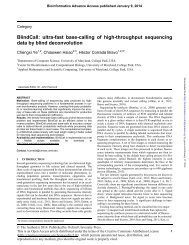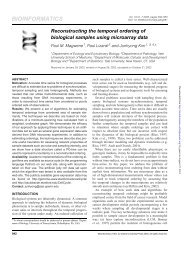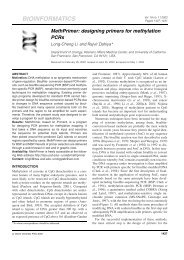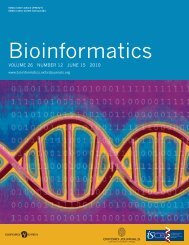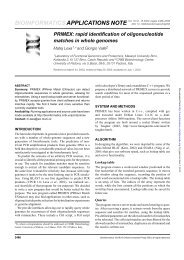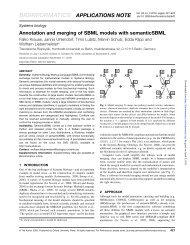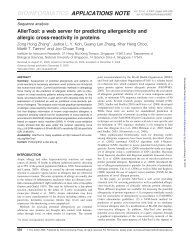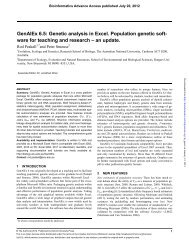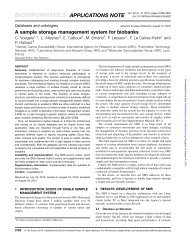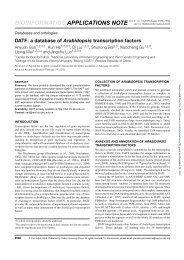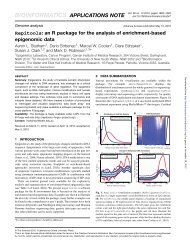Substring selection for biomedical document classification
Substring selection for biomedical document classification
Substring selection for biomedical document classification
You also want an ePaper? Increase the reach of your titles
YUMPU automatically turns print PDFs into web optimized ePapers that Google loves.
other substrings such as ‘residue’ are often related to protein<br />
sequence properties common to all PTMs, which can discriminate<br />
<strong>document</strong>s characterizing protein sequences from other types of<br />
<strong>biomedical</strong> <strong>document</strong>s. Interestingly, some amino acid residues<br />
specific <strong>for</strong> each PTM are in the list, e.g. ‘ragi’ (<strong>for</strong> asparagine<br />
in glycosylation), ‘sole’ (isoleucine <strong>for</strong> hydroxylation), ‘lysine’<br />
(<strong>for</strong> methylation), ‘serin’ and ‘lys’ (serine and lysine <strong>for</strong> phosphorylation).<br />
We further illustrate the usefulness of the <strong>Substring</strong>-Based<br />
approach by considering a specific example from iProLINK<br />
(http://pir.georgetown.edu/iprolink/). The curators labeled abstract<br />
PMID 2606104 in the Acetylation group as positive. They also<br />
marked the evidence tag (showed in italics) within the following<br />
passage of the abstract: ‘The primary structure of glucose-6phosphate<br />
dehydrogenase from rat liver has been determined, showing<br />
the mature polypeptide to consist of 513 amino acid residues,<br />
with an acyl-blocked N-terminus’. Interestingly, although the evidence<br />
tags were not used in learning, 3 of the top 15 acetylation<br />
substrings in Table 3 (<strong>Substring</strong>s selected by the Wilcoxon test),<br />
‘acy’ (ranked at 13), ‘lock’ and ‘termin’, occur within the evidence<br />
tag. This is a strong indication that, in addition to <strong>document</strong> ranking,<br />
the <strong>Substring</strong>-Based algorithm could also be helpful in evidence<br />
tagging. For example, curators could be aided by highlighting portions<br />
of the text with high concentration of highly ranked substrings.<br />
3.5 Ranking of unlabeled abstracts<br />
Using the SB-NB-WRST predictor <strong>for</strong> ranking of glycolysation<br />
<strong>document</strong>s the ranking system was applied to the 1088 untagged<br />
abstracts listed in the 347 PIR-PSD protein entries with glycosylation<br />
sites.<br />
The top and bottom 50 ranked abstracts were selected, merged<br />
and shuffled into the list of 100 abstracts (Supplementary Table<br />
unlabeled glycosylation abstracts). PIR curators were then asked to<br />
read and label these 100 abstracts without knowing the actual ranking<br />
by our system. The results showed 43 out of the highest ranked<br />
50 abstracts were labeled as positive by the PIR curators, while all of<br />
the lowest ranked 50 abstracts were labeled as negative. Further<br />
analysis showed that abstracts of the seven false positive papers<br />
mostly describe characterization of protein primary sequences and<br />
secondary structures, which were the common themes of the positive<br />
training abstracts. For example, the top-ranked negative<br />
abstract (ranked as 22nd) contain in<strong>for</strong>mation about protein<br />
sequences and contain in<strong>for</strong>mative substrings, such as ‘terminal’<br />
and ‘residue’. These results are very encouraging and indicate that<br />
our ranking system is successful in reducing the cost of curation.<br />
From the 43 positive abstracts, we also observed that evidence<br />
related to protein glycosylation is being described in various ways.<br />
Table 4 shows a list of the glycosylation-related words that were<br />
manually extracted from the 43 abstracts, including the number of<br />
abstracts (out of 43) in which they occurred. For example, 19 of the<br />
43 abstracts used only one of the keywords from the table, 3 of<br />
which used only the less-common words such as ‘glycan moiety’<br />
and ‘disaccharide’ when referring to glycosylation. Such a variety<br />
of words, coupled with their internal similarity (most of them contain<br />
substring ‘glyc’), clearly speaks in favor of the <strong>Substring</strong>-Based<br />
approach.<br />
In comparison, we used Word-Based approach WB-NB-WRST<br />
to rank the same untagged abstracts. The results show that 34 out of<br />
the highest ranked 50 abstracts are true positives, while there was 1<br />
<strong>Substring</strong> <strong>selection</strong> <strong>for</strong> <strong>biomedical</strong> <strong>document</strong> <strong>classification</strong><br />
Table 4. Glycosylation-related keywords from the highest-ranked positive<br />
abstracts<br />
Keyword No. of abstracts<br />
Carbohydrate 19<br />
Glycosylate 16<br />
Oligosaccharide 13<br />
Glycopeptide 10<br />
Glycoprotein 7<br />
Glycosylation 5<br />
Glycan Moiety, disaccharide 3<br />
false negative abstract in the lowest ranked 50 abstracts. This is a<br />
further confirmation that <strong>Substring</strong>-Based approach per<strong>for</strong>ms better<br />
than Word-Based approach in our application.<br />
Currently, <strong>biomedical</strong> researchers and curators most often rely on<br />
keyword search (e.g. MEDLINE, Google) to retrieve relevant<br />
in<strong>for</strong>mation. As evident from Table 4, it is often difficult to compose<br />
an appropriate keyword-based query, and approaches such as the<br />
proposed one offer a promising alternative <strong>for</strong> efficient <strong>biomedical</strong><br />
literature search.<br />
4 DISCUSSION<br />
Classification and ranking of <strong>biomedical</strong> <strong>document</strong>s is challenging<br />
owing to the depth and complexity of <strong>biomedical</strong> terminology. We<br />
have observed that traditional Word-Based stemming algorithms,<br />
such as the Porter stemmer, have several drawbacks when used as a<br />
preprocessing step in <strong>classification</strong> of <strong>biomedical</strong> <strong>document</strong>s. The<br />
two main issues that arise are that the conflation of <strong>biomedical</strong> terms<br />
by stemming is too conservative and that stemming might result in<br />
the removal of in<strong>for</strong>mative suffixes. The aim of this paper is to show<br />
that stemming can be successfully replaced by a procedure that<br />
automatically selects the most in<strong>for</strong>mative substrings from a set<br />
of labeled <strong>document</strong>s.<br />
The proposed <strong>classification</strong>/ranking system was evaluated on five<br />
PIR annotated datasets. These datasets are representative of a class<br />
of <strong>biomedical</strong> text mining problems. They are related to tasks of<br />
in<strong>for</strong>mation extraction from large text collections (e.g. MEDLINE)<br />
in which it is difficult to express the search goals in terms of<br />
keyword-based queries. In this case, it is probable that a user<br />
would attempt various queries and obtain long lists of retrieved<br />
<strong>document</strong>s. The user would then start reading the retrieved <strong>document</strong>s<br />
and, through the process, label a number of them as relevant<br />
or irrelevant. Documents labeled in this way open up an opportunity<br />
to apply text <strong>classification</strong> systems that rearrange the unread <strong>document</strong>s<br />
in order of their relevance. Using our ranking system, most<br />
relevant <strong>document</strong>s would appear near the top of the list and significantly<br />
reduce human ef<strong>for</strong>t in literature survey.<br />
Our experiments show that the proposed substring-based<br />
approach is highly effective even when relatively small labeled<br />
datasets are available <strong>for</strong> learning. This result is in contrast with<br />
the behavior of traditional Word-Based algorithms that require large<br />
sets of labeled <strong>document</strong>s in order to approach the accuracy of the<br />
<strong>Substring</strong>-Based algorithm.<br />
It is worth comparing the current ranking system with the<br />
RLIMS-P text mining tool (Hu et al., 2005) that achieved high<br />
2141<br />
Downloaded from<br />
http://bioin<strong>for</strong>matics.ox<strong>for</strong>djournals.org/ by guest on November 18, 2012



